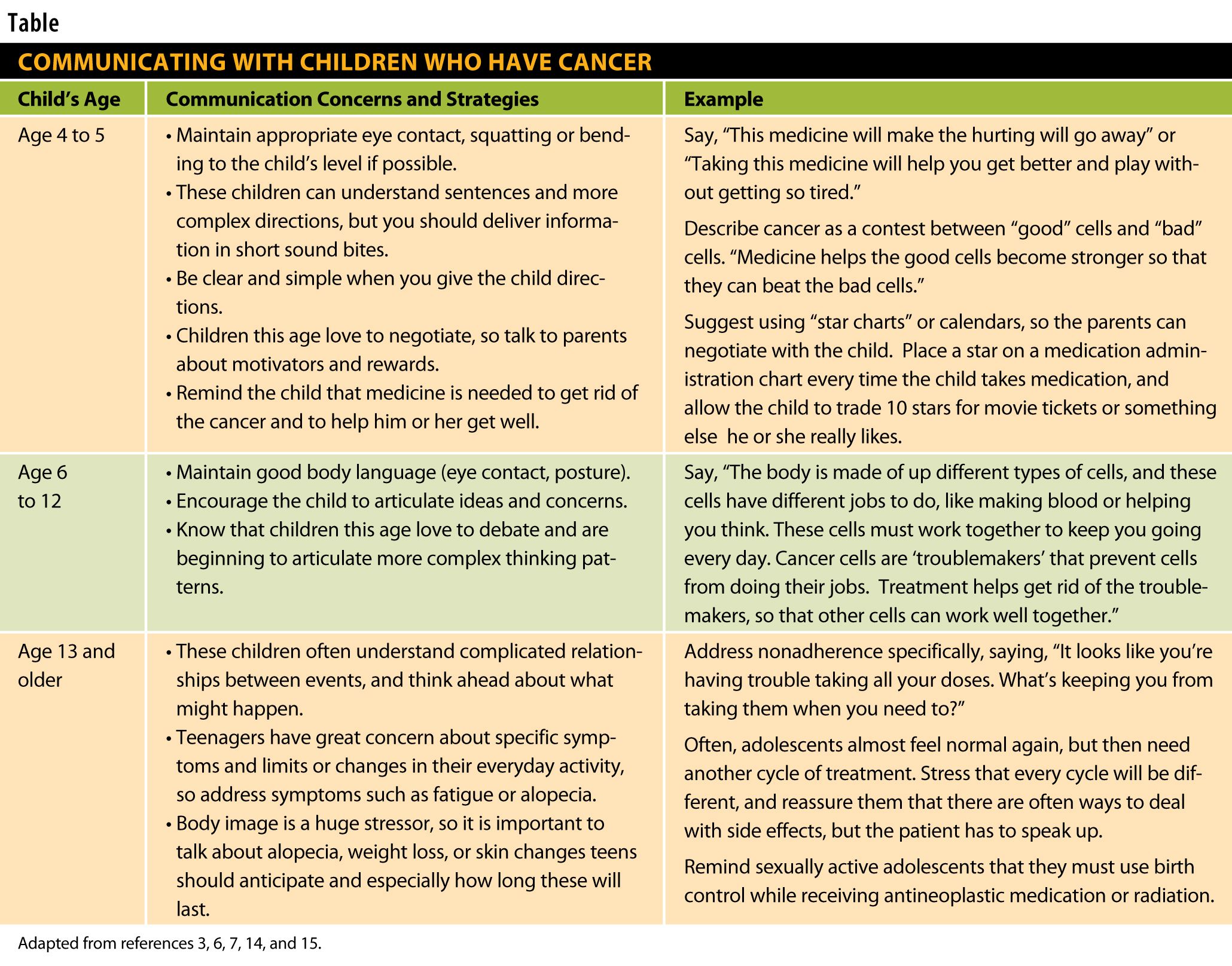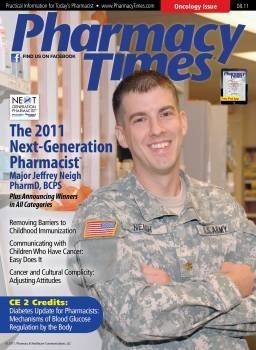Publication
Article
Pharmacy Times
Communicating with Children Who Have Cancer: Easy Does It
Author(s):
Key counseling advice for pharmacists will help them manage young patients and their families in difficult situations and offer age-appropriate support.
As you dispense various prescriptions, they influence your thoughts—how costly a new medication is…things the waiting patient discussed with you when she last visited…whether you should reorder a drug. One doesn’t need to be a mind reader to know what you’re thinking as you process a prescription for oral chemotherapy for a child you know—thoughts such as “Just saw him last week when he needed an antibiotic for otitis.” These can be difficult moments for any pharmacist.
Despite your sadness, there is some good news about cancer. For pediatric cancers—cancers that occur in children younger than 18 years—overall survival rates increased significantly from 1975 to 2001, and today more than 79% of all pediatric cancer patients will survive longer than 5 years. Antineoplastic agents compounded, prepared, and/or dispensed by pharmacists after cancer treatment have been a key component in this success. 1
Regardless, in the pharmacy you’ll be most concerned about keeping your composure when you have to dispense and counsel about this first prescription—and many subsequent ones. Unlike a decade ago, many children now receive intravenous or oral chemotherapy at home.
This is helpful to family life because it minimizes disruption and decreases stress. Home care can also sometimes—but not always—reduce costs associated with treatment, but it requires superb communication between patients, parents or guardians, and all health care providers. 2 When clinicians address fears of the unknown (possible side effects, usual time to response, etc), parents indicate that their stress levels fall.3 Although you’ll talk to parents or guardians most often, there will be times when you’ll need to engage a child and provide information in an age-appropriate way.4
Children’s Needs
When communicating with young cancer patients, most experts believe that honesty is the best policy. Parents may withhold emotionally distressing information from children as a protective strategy—especially if the child is young—believing children won’t understand or “What children don’t know won’t hurt them.”5
Children, however, have an uncanny way of sensing something is wrong. They pick up cues from distressed families, stares and whispers, or when their activities are restricted. Often, they even know how serious their illness is without being told, and may infer their illness or treatment is punishment for something they have done, said, or thought. So protective shielding doesn’t usually work.5, 6 The main point to remember is that the parent or legal guardian is legally entitled and obligated to make all decisions for the child, and you’ll need to follow their lead. If they wish to restrict information, you will have to limit what you say. In addition, the child’s involvement level will depend on his age.7
All patients are entitled to confidentiality, but in the case of children, there are some limits. Precocious children or adolescents sometimes approach pharmacists for information, and ask the pharmacist not to tell their parents. Pharmacists should remember that there are limits to confidentiality in some circumstances. For example, if a minor says she is thinking about suicide, or in some cases, would like birth control, the pharmacist may need to tell the parents.4

Age Matters
Many children lack the understanding and developmental maturity to appreciate what is in their best interest. With the parents’ blessing, pharmacists can help children understand their cancer treatment better. For the most part, pharmacists will most likely counsel older children (as opposed to toddlers), and should gear their guidance to the child’s level of understanding.4 Communication needs will also vary with the stages of the child’s cancer as well as the care setting.3 What most children and their families need is anticipatory guidance.9 They want to know what to expect from each procedure or medication before the procedure is undertaken or the first dose is administered. Diagnosis of cancer is an acute stressor. The often unpredictable course of cancer turns it into a long-term illness that creates a need for lengthy self-management strategies.4
Kids, Cancer, and Compliance
Among cancer patients, failure to adhere to a treatment regimen can result in disease progression or death. Consequently, pharmacists might expect excellent adherence because a young child’s parents are responsible for administering medication. Yet, approximately one-third of children and adolescents with cancer are seriously or occasionally nonadherent.4,10,11 Sometimes, a parent’s confusion stems simply from a lack of understanding, and good counseling can clarify the dosing.
Other barriers to adherence include difficulty swallowing, unpalatable dosage form, parental reluctance to force their gravely ill child to take medication, and large family size (resulting in distraction). 11 Adolescents who have cancer pose a particular challenge. Adolescents’ nonadherence increases precipitously around 20 weeks after diagnosis. This deviation from treatment may be because they believe that they are indestructible or they succumb to peer pressure. They may be nonadherent because taking medication sets them apart or causes side effects that affect their body images.4,12,11
Revving Up Communication
Pharmacists need to be direct with children, and again, understand that children intuit your feelings. They will know if you are not listening to them or are insincere. They need to believe you are competent, and they want to exchange information, not just listen to you lecture. They will find leading questions and veiled coercion offensive.13,6 In short, they need respect. The Table describes some techniques to improve communication with children.13 Always remember that cancer’s impact on the child, family, and community is extreme and enduring, and the entire family will be stressed and in need of support. 3 Bear in mind that it may be appropriate to refer children and adolescents to support groups.14
Conclusion
With more oral and at-home treatment options and better survival making some cancers a chronic condition among pediatric cancer victims, the need for good communication is much greater. Children need to be prepared for possible side effects, and to have an understanding of what is happening, and why, albeit limited by their ability to understand at times. Pharmacists can provide support in ageappropriate ways. Remarkably, most children and parents, through use of changing and successful coping strategies, stay mentally healthy over the long term.8
Ms. Bartok is a medical writer who lives in eastern Connecticut.
References
1. Davis M. Fertility considerations for female adolescent and young adult patients following cancer therapy: a guide for counseling patients and their families. Clin J Oncol Nurs. 2006;10:213-219.
2. Stevens B, McKeever P, Booth M, et al. Home chemotherapy for children with cancer: perspectives from health care professionals. Health Soc Care Community. 2004;12:142-149.
3. McCaffrey CN. Major stressors and their effects on the well-being of children with cancer. J Pediatr Nurs. 2006;21:59-66.
4. Chesson RA, Chisholm D, Zaw W. Counseling children with chronic physical illness. Patient Educ Couns. 2004;55:331-338.
5. Claflin CJ, Barbarin OA. Does “telling” less protect more? relationships among age, information disclosure, and what children with cancer see and feel. J Pediatr Psychol. 1991;16:169-191.
6. Children’s Hospital and Health System. Age-appropriate communication. www.chw.org/display/displayFile.asp?docid=20792&filename=/Groups/CAPFund/cap_age_appropriate_communication.pdf. Accessed June 27, 2011.
7. The Nurse Agency. Age appropriate care through the life span. www.thenurseagency.com/new%20docs/AgeAppropriateCare2005.pdf. Accessed June 27, 2011.
8. Last BF, Grootenhuis MA. Emotions, coping and the need for support in families of children with cancer: a model for psychosocial care. Patient Educ Couns. 1998;33:169-179.
9. Romaire MA, Bell JF. The medical home, preventive care screenings, and counseling for children: evidence from the Medical Expenditure Panel Survey. Acad Pediatr. 2010;10:338-345.
10. Estimates vary, but as much as 20% of new prescriptions never get filled and 85% of refills never leave the pharmacy. www.news-medical.net/?id=965. Accessed January 2005.
11. Tebbi CK, Cummings KM, Zevon MA, Smith L, Richards M, Mallon J. Compliance of pediatric and adolescent cancer patients. Cancer. 1986;58:1179-1184.
12. Partridge AH, Avorn J, Wang PS, Winer EP. Adherence to therapy with oral antineoplastic agents. J Natl Cancer Inst. 2002;94:652-661.
13. Hsiao JL, Evan EE, Zeltzer LK. Parent and child perspectives on physician communication in pediatric palliative care. Palliat Support Care. 2007;5:355-365.
14. Ranmal R, Prictor M, Scott JT. Interventions for improving communication with children and adolescents about their cancer. Cochrane Database Syst Rev. 2008;(4):CD002969.
15. Parker JN, Parker PM. The Official Parent’s Sourcebook on Childhood Non-Hodgkin’s Lymphoma. San Diego, CA: Icon Group International; 2002.







